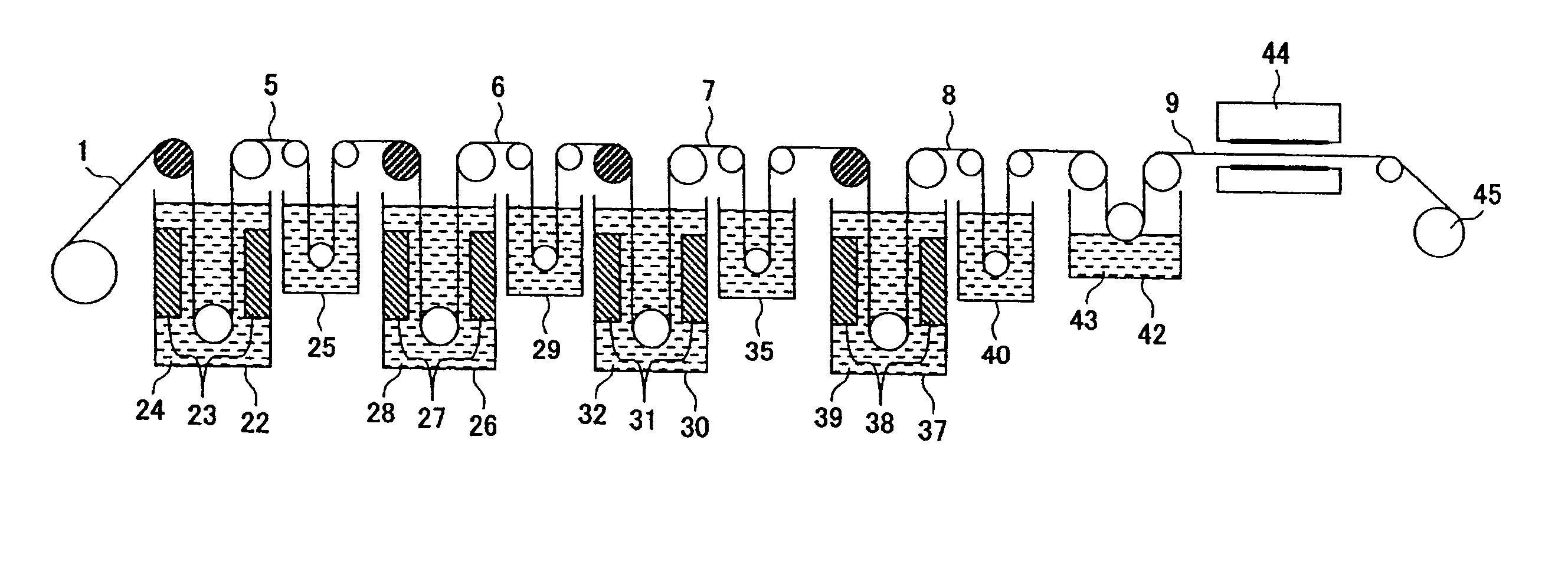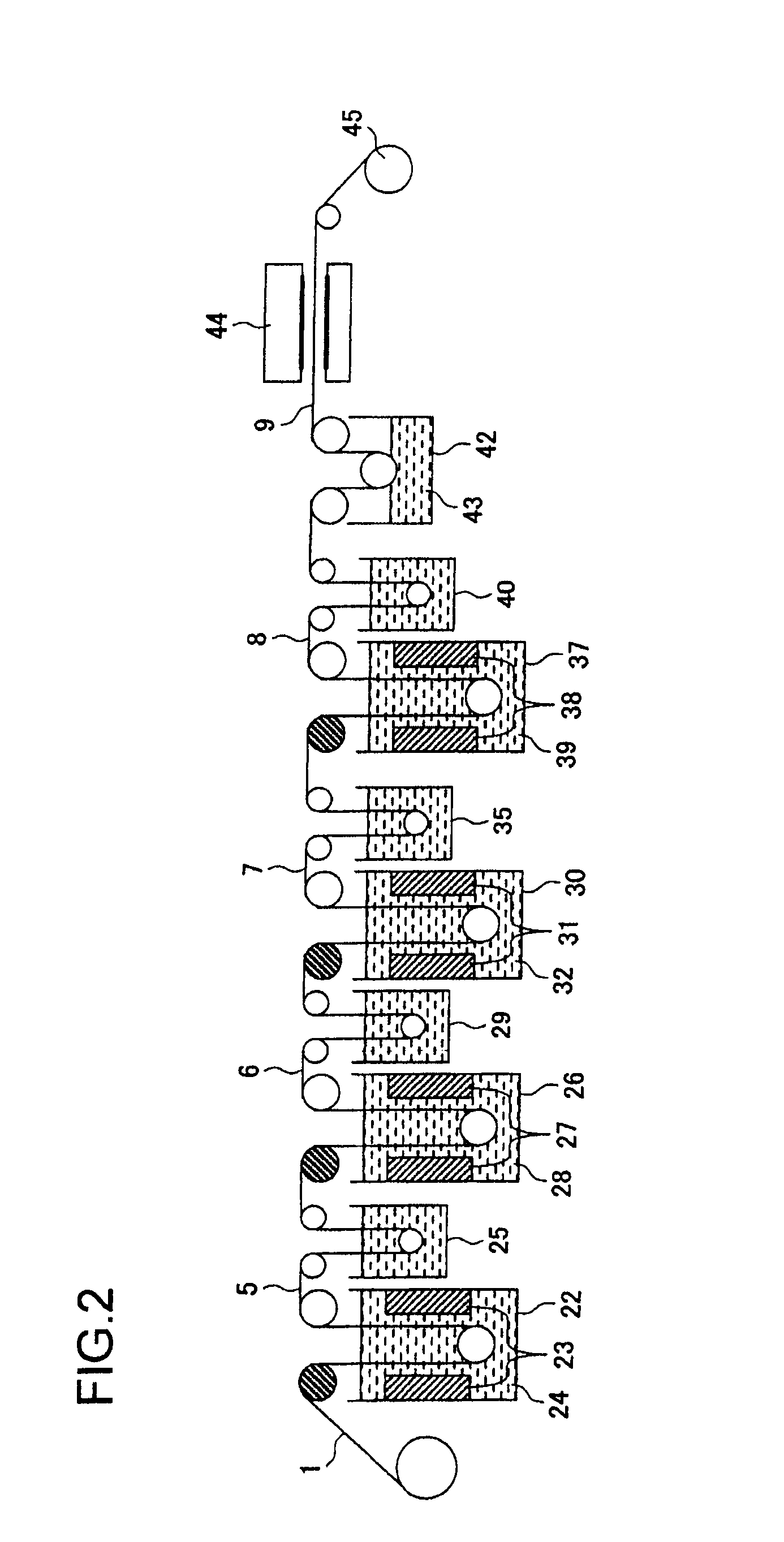Copper foil with resistance layer, method of production of the same and laminated board
a technology of copper foil and resistance layer, which is applied in the direction of superimposed coating process, core/yokes, transportation and packaging, etc., can solve the problems of high ratio of employment of copper foil, difficult to obtain a uniform distribution of roughening particles on the surface of copper foil by fine roughening treatment, etc., to achieve small variation of resistance value, and suitable elasticity and plasticity
- Summary
- Abstract
- Description
- Claims
- Application Information
AI Technical Summary
Benefits of technology
Problems solved by technology
Method used
Image
Examples
example 1
[0059]Use was made of copper foil (MP foil made by Furukawa Electric Co., Ltd.) which was produced under electrodepositing foil production conditions, had a thickness of 18 μm, had a shape roughness on the matte surface side (electrolytic solution surface side) of 4.8 μm in terms of the Rz value prescribed in JIS-B-0601, and had an elongation after heating at 180° C. for 60 minutes under atmospheric heating conditions of 14.2% so as to form a resistance layer thin film for forming a resistance element body on the matte surface side, perform nickel roughening treatment, and perform capsule plating treatment under the following conditions.
[0060][Resistance Layer-Forming Bath Composition and Treatment Conditions]
[0061]As nickel, using nickel sulfamate . . . 65 g / l
[0062]As PO3 of phosphorous acid . . . 40 g / l
[0063]As PO4 of hypophosphorous acid . . . 50 g / l
[0064]Boric acid (HBO3) . . . 30 g / l
[0065]pH: 1.6
[0066]Bath temperature: 55° C.
[0067]Electroplating current density . . . 5.0 A / dm2 ...
example 2
[0086]Except for the use of a copper foil (MP foil produced by Furukawa Electric Co., Ltd.) which was produced under electrodepositing foil production conditions, had a thickness of 18 μm, had a shape roughness on the matte surface side of 4.5 μm in terms of Rz value prescribed in JIS-B-0601, and had an elongation after heating at 180° C. for 60 minutes under atmospheric heating conditions of 14.2%, treatments were carried out under the conditions described in Example 1 for subjecting to the evaluation and measurement.
[0087]The results of measurement and evaluation are described in Table 1.
example 3
[0088]Except for the use of a copper foil (MP foil produced by Furukawa Electric Co., Ltd.) which was produced under electrodepositing foil production conditions, had a thickness of 18 μm, had a shape roughness on the matte surface side of 4.5 μm in terms of Rz value prescribed in JIS-B-0601, and had an elongation after heating at 180° C. for 60 minutes under atmospheric heating conditions of 12.0%, treatments were carried out under the conditions described in Example 1 for subjecting to the evaluation and measurement.
[0089]The results of measurement and evaluation are described in Table 1.
PUM
| Property | Measurement | Unit |
|---|---|---|
| elongation | aaaaa | aaaaa |
| temperature | aaaaa | aaaaa |
| roughness | aaaaa | aaaaa |
Abstract
Description
Claims
Application Information
 Login to View More
Login to View More - R&D
- Intellectual Property
- Life Sciences
- Materials
- Tech Scout
- Unparalleled Data Quality
- Higher Quality Content
- 60% Fewer Hallucinations
Browse by: Latest US Patents, China's latest patents, Technical Efficacy Thesaurus, Application Domain, Technology Topic, Popular Technical Reports.
© 2025 PatSnap. All rights reserved.Legal|Privacy policy|Modern Slavery Act Transparency Statement|Sitemap|About US| Contact US: help@patsnap.com



